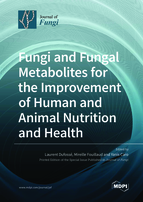Fungi and Fungal Metabolites for the Improvement of Human and Animal Nutrition and Health
A special issue of Journal of Fungi (ISSN 2309-608X). This special issue belongs to the section "Fungal Cell Biology, Metabolism and Physiology".
Deadline for manuscript submissions: closed (31 October 2020) | Viewed by 120723
Special Issue Editors
Interests: sustainable textile; microbial biotechnology; microbial production of pigments and colorants; fermentation; bioprocess engineering and fermentation technology
Special Issues, Collections and Topics in MDPI journals
Interests: microbiology; biotechnology; specialized metabolites; fermentations; pigments
Special Issues, Collections and Topics in MDPI journals
Interests: fermentation; industrial biotechnology; marine fungi; fungal pigments; anthraquinones; chemistry of lipids; biodiesel
Special Issues, Collections and Topics in MDPI journals
Special Issue Information
Dear Colleagues,
Fungi comprise 1, 2, 3, ..., or maybe around 5.1 million species? Even scientists do not currently agree on how many fungi species may be found on planet Earth, with only around 120,000 of these having been described so far. Fungi have been classified as a separate Kingdom of organisms as complex and diverse as plants and animals, of which only a few percent have been named and described. Fungal biomasses and fungal metabolites share a long common history with human and animal nutrition and health. Macrofungi and filamentous fungi constitute a large portfolio of proteins, lipids, vitamins, minerals, oligo elements, pigments, colorants, bioactive compounds, antibiotics, pharmaceuticals, etc. For example, industrially important enzymes and microbial biomass proteins have been produced from fungi for more than 50 years. Some start-ups convert byproducts and side streams rich in carbohydrates into a protein-rich fungal biomass. This biomass can then be processed into a vegan meat substitute for food applications. In recent years, there has also been a significant increase (in fact, a significant revival) in the number of publications in the international literature dealing with the production of lipids by microbial sources (the single-cell oils (SCOs) that are produced by the so-called “oleaginous” microorganisms, including “oleaginous” fungi such as zygomycete species, e.g., Cunninghamella echinulata and Mortierella isabellina). Fungi are potential sources of polyunsaturated fatty acids (PUFAs) as these microorganisms can accumulate large amounts of high-valued PUFAs, such as gamma-linolenic acid (GLA) and arachidonic acid (ARA).
The purpose of this Special Issue of Journal of Fungi (MDPI) is not to provide a comprehensive overview of the vast arena of how fungi and fungal metabolites are able to improve human and animal nutrition and health; rather, we, as Guest Editors, wish to encourage authors working in this field to publish their most recent work in this rapidly growing journal in order for the large readership to appreciate the full potential of wonderful and beneficial fungi. Thus, this Special Issue welcomes scientific contributions on applications of fungi and fungal metabolites, such as bioactive fatty acids, pigments, polysaccharides, alkaloids, terpenoids, etc., with great potential in human and animal nutrition and health.
Prof. Dr. Laurent Dufossé
Dr. Mireille Fouillaud
Dr. Yanis Caro
Guest Editors
Manuscript Submission Information
Manuscripts should be submitted online at www.mdpi.com by registering and logging in to this website. Once you are registered, click here to go to the submission form. Manuscripts can be submitted until the deadline. All submissions that pass pre-check are peer-reviewed. Accepted papers will be published continuously in the journal (as soon as accepted) and will be listed together on the special issue website. Research articles, review articles as well as short communications are invited. For planned papers, a title and short abstract (about 100 words) can be sent to the Editorial Office for announcement on this website.
Submitted manuscripts should not have been published previously, nor be under consideration for publication elsewhere (except conference proceedings papers). All manuscripts are thoroughly refereed through a single-blind peer-review process. A guide for authors and other relevant information for submission of manuscripts is available on the Instructions for Authors page. Journal of Fungi is an international peer-reviewed open access monthly journal published by MDPI.
Please visit the Instructions for Authors page before submitting a manuscript. The Article Processing Charge (APC) for publication in this open access journal is 2600 CHF (Swiss Francs). Submitted papers should be well formatted and use good English. Authors may use MDPI's English editing service prior to publication or during author revisions.
Keywords
- microfungi
- macrofungi
- filamentous fungi
- antioxidant
- Ganoderma
- kombucha
- anticancer
- carotenoid
- medicinal mushrooms
- mycobiome
- antimicrobial
- antifungal
- bioconversion
- feed additive
- cheese
- dairy
- Sclerotinia
- secondary metabolites









